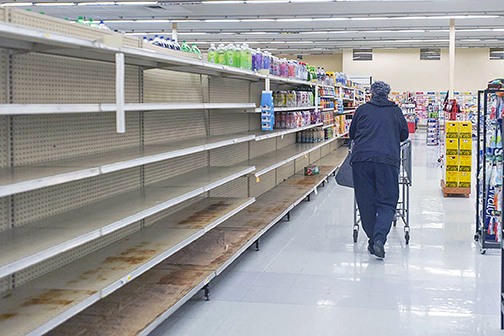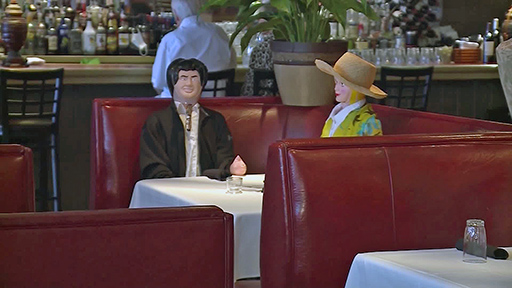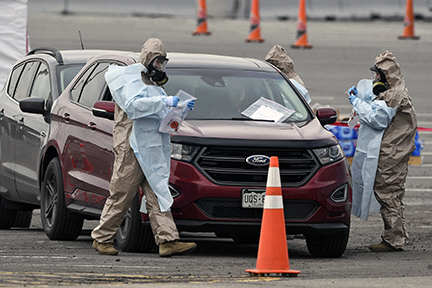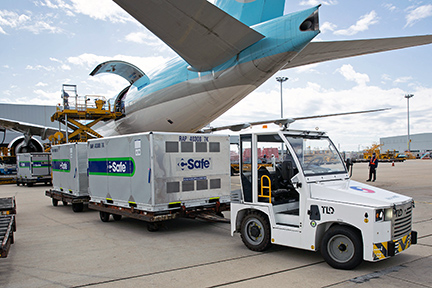Has there ever been a year like 2020 in our lifetimes? Because of a virus, 2020 was filled with a lifetime of events, all happening in one year. And many of the challenges we endured are ongoing as the year 2021 emerges. However, with vaccines on the way, there are hopes that the challenges of 2020 will soon be a memory. Most will say “good riddance” to a year that paralyzed almost the entire world and changed life as we know it to a life of cancellations and drastic adjustments. . .including our jobs, our families, and all the things we took for granted.
COVID-19 emerges and the world isn’t the same
 In December 2019, the novel coronavirus was detected in Wuhan, China. The World Health Organization (WHO) recognized the mysterious virus on January 9, 2020, and deemed it a public health emergency, the highest level of alarm under international law. On January 11, Chinese officials shared news of the virus with governments around the world.
In December 2019, the novel coronavirus was detected in Wuhan, China. The World Health Organization (WHO) recognized the mysterious virus on January 9, 2020, and deemed it a public health emergency, the highest level of alarm under international law. On January 11, Chinese officials shared news of the virus with governments around the world.
The WHO expected cases to emerge outside of China, which they did almost immediately. By January 13, 2020, the first case of what would eventually be called COVID-19 appeared in Thailand. Within days, the virus had circulated to Korea, Japan and Singapore.
In response, the WHO made its first field visit to Wuhan to activate surveillance of the disease and to develop a test kit to detect the particular form of the coronavirus. While there, WHO staffers began to plan the visits of international experts to develop countermeasures such as treatments and vaccines. WHO Director-General Tedros Adhanom Ghebreyesus said in statement “Make no mistake. This is an emergency in China, but it has not yet become a global health emergency. It may yet become one.”
The next week, two very important events surrounding the virus occurred. First, the Centers for Disease Control and Prevention confirmed the first U.S. coronavirus case in Washington State. Some claimed the first case was in Northern California. Regardless, the virus had made its way to the United States.
On the same day (January 21), a Chinese scientist confirmed that the novel coronavirus was being transmitted from human to human. At that point, U.S. officials began screening passengers at three airports where the majority of flights from Wuhan arrive and depart — JFK International, Los Angeles International and San Francisco International.
By February 2, 2020, several countries —
including the U.S., Italy, Australia, Germany and New Zealand — restricted global air travel from China. The day after the WHO declared a public health emergency, the U.S. did the same as almost 10,000 cases and 200 deaths were seen worldwide.
On February 11, at a WHO meeting, Tedros became much more urgent in his appeals to the public. He said, “To be honest, a virus is more powerful in creating political, economic and social upheaval than any terrorist attack. A virus can have more powerful consequences than any terrorist action, and that’s true. If the world doesn’t want to wake up and consider this enemy virus as Public Enemy Number 1, I don’t think we will learn our lessons.” Not everyone listened to Tedros’ warning.
In late February, the CDC said that two of the three criteria to officially call COVID-19 a pandemic were cited. Those three factors include illness resulting in death, human-to-human spread of the virus and worldwide spread. At that time, the worldwide spread was not officially cited by the CDC.
However, by the end of February, the World Health Organization decided to publish a press release that raised the global risk of the virus from “high” to “very high.”
On March 11, the WHO declared COVID-19 a worldwide pandemic and the director general of the organization said that the spread is “concerning.” He also expressed concern about “the alarming levels of inaction” to fight the virus by countries throughout the world, specifically the United States and the United Kingdom.
President Trump’s response to the rise of COVID-19
When the virus was discovered in January, President Trump said to CNBC, “We have it totally under control. It’s one person coming in from China, and we have it under control. It’s going to be just fine.”
In March, a week before the WHO officially declared COVID-19 a worldwide pandemic, President Trump said at a political rally in New Hampshire that the virus would disappear by April when the weather warms. He used the word “miraculously.” He also told a group of governors in early March that the virus would disappear, all the while, literally nothing was being done to fight the virus in the U.S. At the same time, many countries had already put into place strict defenses that the U.S. failed to do.
President Trump’s cavalier response to the worst pandemic in four generations could have been the primary reason he was not re-elected in November. No one will ever know whether that is true or not. Regardless, there was no question that the U.S. as a whole was completely unprepared for the contagion two months into it.
 On March 15, the NCAA did not release brackets for the men’s or women’s basketball tournaments, canceling all remaining Division I winter and spring sports. To many, those major sports cancellations were the first big wakeup call in the U.S. surrounding the coronavirus. When March Madness was canceled, bars, restaurants and virtually every retail and service establishment throughout the nation were still open at full capacity. Shortly after the cancellation of the rest of winter and all of spring sports, Trump declared COVID-19 a national emergency. The declaration unleashed billions of dollars to fight the virus’ spread. By March 26, the U.S. led all nations in coronavirus infections.
On March 15, the NCAA did not release brackets for the men’s or women’s basketball tournaments, canceling all remaining Division I winter and spring sports. To many, those major sports cancellations were the first big wakeup call in the U.S. surrounding the coronavirus. When March Madness was canceled, bars, restaurants and virtually every retail and service establishment throughout the nation were still open at full capacity. Shortly after the cancellation of the rest of winter and all of spring sports, Trump declared COVID-19 a national emergency. The declaration unleashed billions of dollars to fight the virus’ spread. By March 26, the U.S. led all nations in coronavirus infections.
President Trump’s tune changed dramatically. At a press briefing at the White House, Trump said about the virus: “My administration is recommending that all Americans, including the young and healthy, work to engage in schooling from home when possible. Avoid gathering in groups of more than 10 people. Avoid discretionary travel. And avoid eating and drinking at bars, restaurants and public food courts. If everyone makes these critical changes and sacrifices now, we will rally together as one nation and we will defeat the virus. And we’re going to have a big celebration all together. With several weeks of focused action, we can turn the corner and turn it quickly.” The next day he said, “This is a pandemic. . .I felt it was a pandemic long before it was called a pandemic.”
The early economic impact of the virus on the U.S.
 By mid-March, many local and statewide economies in the U.S. were forced into lockdown and only essential services — such as grocery stores and gas stations — were open for business. Schools, bars, restaurants, gyms, theaters, hotels, event spaces and salons, among other businesses, were closed for weeks. Travel was shut down as airlines saw drops as high as 96 percent in passenger traffic. Airliners were parked wherever they could find the space.
By mid-March, many local and statewide economies in the U.S. were forced into lockdown and only essential services — such as grocery stores and gas stations — were open for business. Schools, bars, restaurants, gyms, theaters, hotels, event spaces and salons, among other businesses, were closed for weeks. Travel was shut down as airlines saw drops as high as 96 percent in passenger traffic. Airliners were parked wherever they could find the space.
During the last two weeks of March, the U.S. saw nearly 10 million new unemployment claims. As the pandemic worsened in April, business closures and layoffs spiked to the highest level in U.S. history. Total non-farm payroll employment fell by 20.5 million in the U.S. in April. Peak weekly unemployment claims occurred the week of March 28, when 6.9 million filed for first-time unemployment assistance. To give you an idea of what a massive crater that was in unemployment claims, the peak week prior to March 28, 2020, was 650,000 claims in 2008 during the Great Recession. So, ten times the previous peak in unemployment claims occurred in March of 2020.
CARES Act passed by Congress March 27, 2020
Following the shock to the economy in March, Congress put together the largest ever economic assistance package for American small businesses, workers and families on March 27, 2020. Called the Coronavirus Aid, Relief, and Economic Security Act (CARES Act), the aid was passed with bipartisan support and the law was signed by President Trump.
The act provided up to $1,200 per adult and $500 per child under 17 years old for individuals whose income was less than $99,000 per year. For small businesses, the Paycheck Protection Program was part of the CARES Act. The program provided small businesses up to eight weeks of payroll costs including benefits. In addition, as part of the CARES Act, federal lawmakers enacted a $600 a week supplement to unemployment benefits (that expired in July). Overall, the relief package was worth $2.2 trillion, more than double the aid that Congress provided during the Great Recession from 2007 to 2009. While it’s likely that some who didn’t need the aid got it, the CARES Act helped millions of small businesses and families stay afloat for a short period of time.
By the start of the second quarter, the economy was in a deep dive. In less than 60 days, the U.S. found itself in a deep recession. The coronavirus pandemic, as it was defined by the WHO at the end of the first quarter, triggered the deepest reduction in gross domestic product in the nation’s modern-day history. The longest economic expansion in the U.S. — 113 consecutive months of job growth that began in June 2009 — was now over by the end of the first quarter, and it got worse by the second quarter of 2020.
Gross domestic product — easily the best method of judging an economy — fell by an enormous annual rate of 32.9 percent (9.1 percent for the quarter) in the second quarter. That is more than three times the previous annual record of GDP decline, which was a 10 percent drop in 1958. On a quarterly basis, the 9.1 percent drop in GDP in the second quarter of 2020 was more than triple the previous high of 3 percent since records first began.
In the second quarter, the consumer economy ground to a halt as retailers and almost everything in the service economy shut down in an effort to slow the spread of the virus. In an NPR article published in July, chief economist at IHS Markit, Nariman Behravesh, called the enormous downturn in GDP in the second quarter “horrific.”
 Retail sales between February and March declined 8.7 percent, the largest monthly drop in consumer goods purchased since the Census Bureau began tracking the data. Essential businesses such as supermarkets and pharmacies saw sales increase at the beginning of the virus, however, other retail (such as furniture, clothing and appliances) saw steep declines in sales. Restaurants, bars and gas stations also saw deep slumps in sales (if they even had any sales at all).
Retail sales between February and March declined 8.7 percent, the largest monthly drop in consumer goods purchased since the Census Bureau began tracking the data. Essential businesses such as supermarkets and pharmacies saw sales increase at the beginning of the virus, however, other retail (such as furniture, clothing and appliances) saw steep declines in sales. Restaurants, bars and gas stations also saw deep slumps in sales (if they even had any sales at all).
By the second quarter, businesses that were open (whether they were services or manufacturing), were limited as a result of social distancing and other protective measures that were put in place to quell the spread of the virus. Manufacturing stations were placed further apart from each other. Service sector locations such as retail stores, restaurants and other businesses, were forced to operate at reduced occupancy. Masks and social distancing were required at factories and service locations alike. Restaurants cobbled together takeout service. . .closing their dining rooms and creating “touchless” delivery.
In the second quarter, millions were working from home. That is still the case as the year ends. According to several sources, more than 65 percent of workers were still working from home in May. This had an incredible effect on subleases of office space throughout the South as offices sat empty. In Dallas-Fort Worth, one of the South’s most dynamic economies, over 8 million square feet of office space was actively being marketed as sublease space in the fall quarter.
School closures create recession for women
Because so many schools were closed in the first and second quarters of 2020, the COVID-19 pandemic created what can only be described as a recession for women. The gains seen in the recovery from 2009 to 2020 for women were the greatest ever in this country. Yet, by the end of the second quarter according to the Labor Department, the unemployment rate was at 10 percent for women of color and 7.3 percent for white women.
Mothers were three times more likely than fathers to lose their jobs during the first four months of the pandemic. Mothers of 12-year-olds and younger lost 2.2 million jobs from February to August because many of them were forced to stay at home with children whose schools were closed. Additionally, as many as 640,000 teachers, most of which were women, lost their jobs between February and August.
May 2020: Some states begin to ease restrictions
After more than a couple of months in lockdown mode, the month of May saw some comeback in the economy as virus restrictions began to loosen. Some states in the South like Georgia, Florida and Texas eased restrictions in the services sector such as restaurants and bars. Even with social distancing measures in place, sales in the services sector rose almost 18 percent from April to May. That 18 percent was the largest month-to-month increase in sales ever in the services sector.
By the third week in April, most states that had imposed stay-at-home orders had begun to loosen restrictions. Depending on the state, restaurants, bars, offices and churches were allowed to operate incorporating six feet of distancing and mask wearing. In some states, gyms and hair and nail salons could open under certain rules, and the reestablishment of on-property consumption of food and drink was allowed. This also included the resumption of sports activities.
On May 28, U.S. COVID-19 deaths passed the 100,000 mark. The CDC issued a statement saying in part the 100,000 deaths were a “sobering development and a heart-breaking reminder of the horrible toll of this unprecedented pandemic.”
With the opening of the economy at President Trump’s urging in April and May, new infections continued to rise in about two dozen states. In June, cases began to spike, especially in Southern states such as Texas and Florida, and both states decided to slow re-openings of businesses. Also in June, Dr. Anthony Fauci, the director of the National Institute of Allergy and Infectious Diseases, told a Senate, Health, Education, Labor and Pensions Committee that while cases were averaging about 40,000 a day at the time, infections could reach 100,000 a day based on the current trajectory.
 By the first week of August, the U.S. had only regained 9.2 million jobs of the 22 million lost in the first seven months of the pandemic. The largest sector to lose jobs by the start of the third quarter was restaurants. In the first months of the virus, restaurants and bars lost over 6 million jobs. By August, that sector had recaptured just 57 percent of its jobs.
By the first week of August, the U.S. had only regained 9.2 million jobs of the 22 million lost in the first seven months of the pandemic. The largest sector to lose jobs by the start of the third quarter was restaurants. In the first months of the virus, restaurants and bars lost over 6 million jobs. By August, that sector had recaptured just 57 percent of its jobs.
Retail, which saw the second largest job loss of any sector at 2.4 million, regained 62 percent of its jobs by August. Manufacturing, which lost about 640,000 jobs from February to August, regained only 46 percent of its jobs. And professional and business services, which lost about 2.3 million jobs by August, had regained just 28 percent of its sector’s jobs according to the Bureau of Labor Statistics. Hotels, which lost about 1 million jobs, brought back 22 percent of the jobs lost by August.
By September, the opening up of the economy in the spring was looking like a mistake. Coronavirus cases were again spiking and job gains slowed. In September, employers added just 661,000 jobs, the third consecutive month of slowing job growth. In September, the economy had lost nearly 11 million jobs. In the Great Recession, peak job losses totaled 8.7 million. September was the first month that indicated that many job losses would be permanent and not just furloughs.
By the beginning of the third quarter when job growth and the economy at large had slowed, it seemed apparent to just about everyone, including the president and Congress, that another large round of stimulus was needed. After all, virtually every dollar doled out in the CARES Act in the spring and early summer was spent. That goes hand-in-hand with the data from the Bureau of Labor Statistics that showed 3.8 million jobs had been permanently lost. During the early months of the pandemic (and after checks cleared from the federal government from the CARES Act), many employees were temporarily laid off. With no new federal aid by December, many of the jobs lost in September changed from furloughs to permanent.
Vaccines and better tests emerge
In July, early Moderna trials of its vaccine showed immune responses in all three groups of 15 volunteers. Later in July, Moderna began Phase 3 trials after receiving $472 million to expand the tests to 30,000 volunteers. Another vaccine from AstraZeneca and BioNTech also showed early promise in fighting the virus. In September, that vaccine expanded into a Phase 3 trial.
As cases became more widespread in August, the U.S. entered a $2.1 billion deal with GlaxoSmithKline and Sanofi Pasteur in an effort to scale up another vaccine. That same month, the U.S. signed a second deal — totaling $1.5 billion — with Moderna for 100 million doses of its vaccine. Johnson & Johnson also began Phase 3 clinical trials for its vaccine in September.
Tests for COVID-19 have been slow to show up and slow to get results. Many healthcare workers in the first, second and beginning of the third quarter had not yet been tested. But in August, the FDA approved SalivaDirect, a test developed by researchers at the Yale School of Public Health. The saliva test is less invasive than the swab test and is inexpensive.
Abbott also developed a test in September. The new Abbott tests are cheaper and faster than the swap tests done in a lab and the results can be seen in 15 minutes.
Finally, in September, the Trump administration released vaccine distribution plans. The plan was devised by the U.S. Department of Health and Human Services and the Department of Defense.
President Trump contracts COVID-19
After several in his staff tested positive for the virus and after several indoor and outdoor functions and rallies, President Trump and First Lady Melania tested positive for the virus. On Friday, October 2, Trump was taken to Walter Reed National Military Medical Center where he was given a dose of Regeneron, the experimental drug cocktail that has shown encouraging results improving coronavirus symptoms.
White House Chief of Staff Mark Meadows reported that Trump’s vitals were concerning to doctors and that several more people close to the president had tested positive. On Saturday night, Trump’s physician released a letter that read the president had started his first dose of Remdesivir. On Sunday, Trump had turned a corner and his doctor said that he hoped the president would be released on Monday.
Trump departed Walter Reed on Monday evening via Marine One, about 72 hours after he first arrived at the hospital. Wearing a mask, then taking it off, Trump walked up the stairs of the South Portico entrance, gave a thumbs up and walked into the White House.
By the beginning of the fourth quarter, some positives in the economy began to show up. In October, employment rose by 638,000 jobs according to BLS, a gain of really nothing from the month before. COVID-19 cases began to surge. By October, the economy was 8.9 million jobs below its February totals when the pandemic first emerged, or just less than half of jobs lost during the length of the pandemic.
As businesses reopened ever more in September and October — some probably too fast because of the virus — real gross domestic product rose at an annual rate of 33.1 percent in quarter three. That figure was almost exactly the loss of projected annual GDP of 32.9 percent in the second quarter of 2020. While GDP was approaching levels prior to quarter two in 2020, employment remained way behind pre-pandemic levels.
With GDP recovering at the start of the fourth quarter, the Trump administration on WhiteHouse.gov claimed that the president led “what is on track” to be the “fastest economic recovery in American history.” Technically, the White House’s claim was correct. However, the problem with that argument is that the administration also oversaw the largest crater in its economy ever. At no point since numbers were tabulated has the United States seen an economic collapse like the second quarter of 2020. As businesses opened after closing in quarter two, there was only one way for the economy to go and that was up.
The White House also reported the fact that a surge in wages occurred in quarter three. That was almost completely due to the fact that many low wage-earners — restaurant and retail workers — lost their jobs during the pandemic at a disproportionate rate. If those low-wage jobs lost were not factored among all job earners, the average hourly wage would naturally climb dramatically.
Meanwhile, COVID-19 cases surge in the fourth quarter
In March and April, with much of the economy in lockdown, the highest number of cases per day in the U.S. was just over 30,000. By the end of July, after some of the restrictions were eased, cases rose on some days to over 75,000. After a slowing of daily cases in September, October saw some days with 80,000 new cases. By November, cases surged up to 190,000 a day and over 200,000 by the start of December. As the last month of the year began, the U.S. had nearly 15 million cases and about 300,000 deaths.
The recovery from the virus
A recovery from this virus cannot come soon enough as millions go hungry and this pandemic continues to devastate people and paychecks. During this almost year-long pandemic, the number of those seeking ways to feed themselves has increased from 35 million to over 50 million. Food lines in some cases are miles long. Many of these people have not asked for this kind of assistance in their entire lives. And nearly 7 million households are at risk of eviction January 1 as federal and local eviction moratoriums expired.
While the fall and summer saw job creation averaging about 650,000 a month, November’s totals took a dive. Only 245,000 jobs were created in November. And in the first week of December, 712,000 workers filed for unemployment. So, as this virus peaks again at the start of winter, the U.S. economy is going backwards.
The November unemployment rate fell to 6.7 from 6.9 percent, according to the Bureau of Labor Statistics, but the decrease in unemployment was because of workers leaving the labor force. While the economy as of December is not contracting as it did in the second quarter, it certainly is growing slower as cases accelerate.
 As of December, airlines are flying doses of the various vaccines to places around the world. However, as of this writing, the vaccines are still unproven to a degree and distribution is still a question mark. The vaccines, if safe and effective, should eliminate another lockdown like the second quarter of 2020. The vaccines should also eliminate a renewed surge in the virus, which as of early December was swelling like never before. Obviously a decline in cases is the number one factor as we begin the economic recovery of 2021. We have written many times in 2020 that the economy is all about the virus. We can now write that the economic recovery is all about the vaccine, its effectiveness and distribution.
As of December, airlines are flying doses of the various vaccines to places around the world. However, as of this writing, the vaccines are still unproven to a degree and distribution is still a question mark. The vaccines, if safe and effective, should eliminate another lockdown like the second quarter of 2020. The vaccines should also eliminate a renewed surge in the virus, which as of early December was swelling like never before. Obviously a decline in cases is the number one factor as we begin the economic recovery of 2021. We have written many times in 2020 that the economy is all about the virus. We can now write that the economic recovery is all about the vaccine, its effectiveness and distribution.
The Brookings Institution reported in the fall quarter that another $2 trillion stimulus would bring the U.S. economy back to pre-pandemic levels by mid-2021, and would raise gross domestic product by 4 percent in 2021 and 2022.
As of this writing, another large stimulus has not been approved. It is imperative that another round of aid is needed. Without one, the speed of recovery will undoubtedly be affected. By the first week in December, it looks as if Congress is on the cusp of passing some sort of aid. How much is the question.